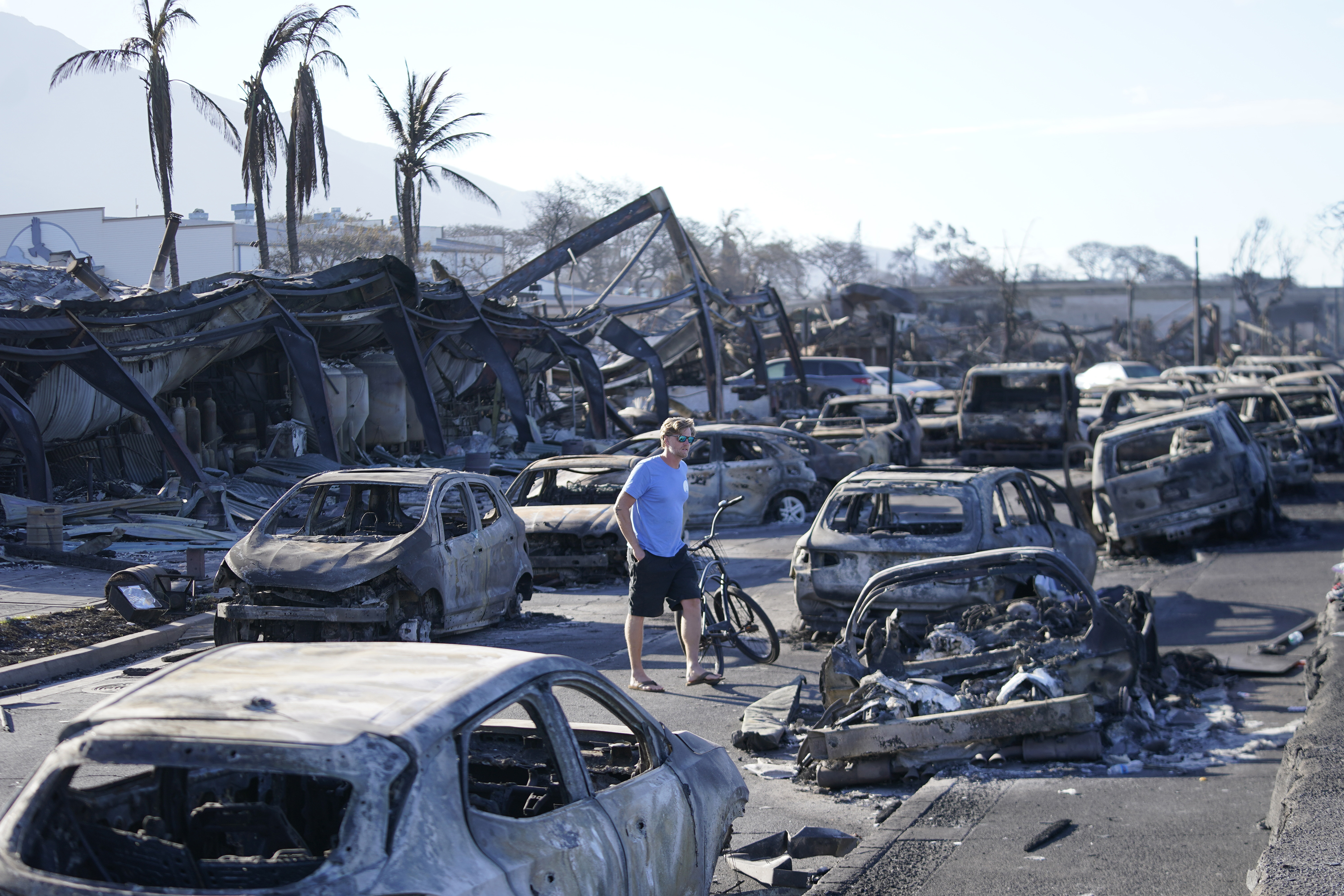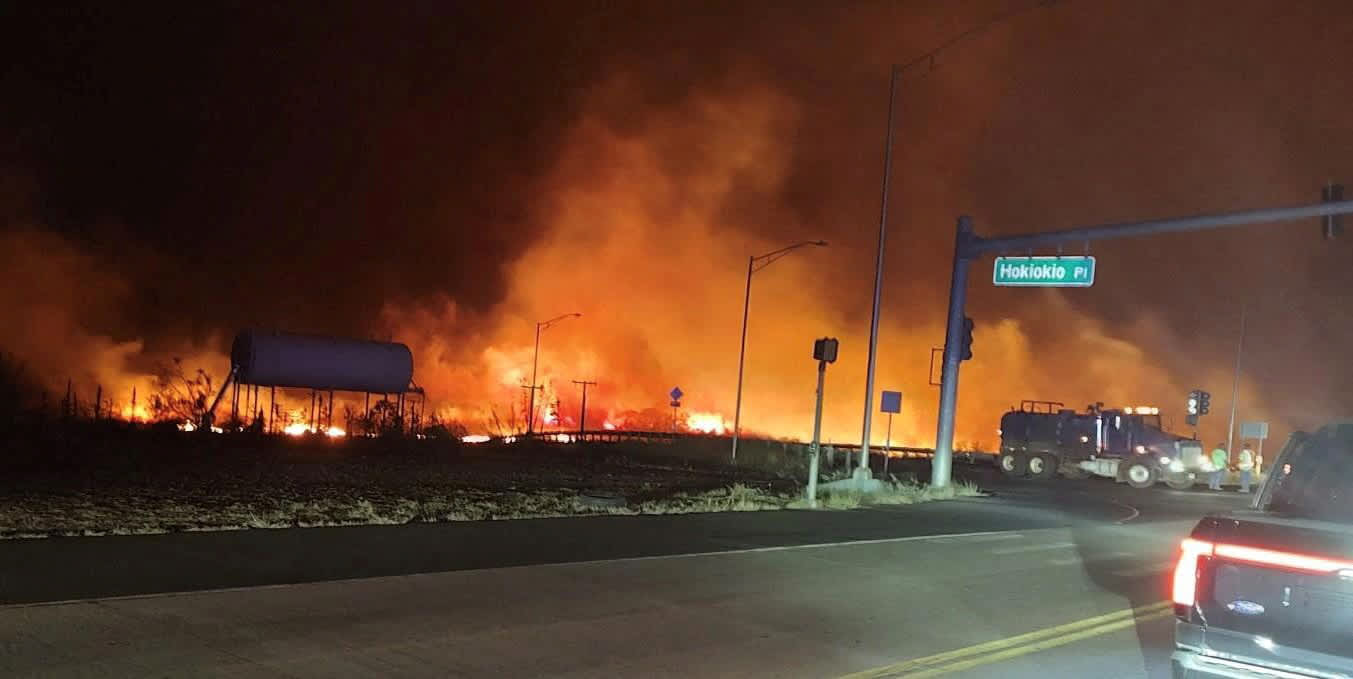Deadly wildfires that swept with alarming speed and strength through the Hawaiian island of Maui reduced hundreds of homes to ash, sending emergency workers scrambling Saturday to find temporary housing for those lucky enough to survive a conflagration that has taken at least 80 lives.
The astonishing scope of the devastation became clearer Saturday, but communications were still difficult, with 30 cell towers still offline. Power outages were expected to last several weeks on the western side of the island. Authorities, meanwhile, warned that the death toll could rise as search efforts continue.
Those who escaped were counting their blessings, thankful to be alive as they mourned those who didn't make it.
Retired fire captain Geoff Bogar and his friend of 35 years, Franklin Trejos, initially stayed behind to help others in Lahaina and save Bogar's house. But as the flames moved closer and closer Tuesday afternoon, they knew they had to get out. Each escaped to his own car. When Bogar's wouldn't start, he broke through a window to get out, then crawled on the ground until a police patrol found him and brought him to a hospital.
We're making it easier for you to find stories that matter with our new newsletter — The 4Front. Sign up here and get news that is important for you to your inbox.
Trejos wasn't as lucky. When Bogar returned the next day, he found the bones of his 68-year-old friend in the back seat of his car, lying on top of the remains of his beloved 3-year-old golden retriever Sam, whom he had tried to protect.
Trejos, a native of Costa Rica, had lived for years with Bogar and his wife, Shannon Weber-Bogar, helping her with her seizures when her husband couldn't. He filled their lives with love and laughter.
“God took a really good man,” Weber-Bogar said.
Bill Wyland, who lives on the island of Oahu but owns an art gallery on Lahaina's historic Front Street, fled on his Harley Davidson, whipping the motorcycle onto empty sidewalks Tuesday to avoid traffic-jammed roads as embers burned the hair off the back of his neck.
Riding in winds he estimated to be at least 70 miles per hour (112 kilometers per hour), he passed a man on a bicycle who was madly pedaling for his life.
“It’s something you’d see in a Twilight Zone, horror movie or something,” Wyland said.
Wyland, who noticed others stuck in traffic or leaping into the ocean to escape the flames, realized just how lucky he had been when he returned to downtown Lahaina on Thursday.
“It was devastating to see all the burned-out cars. There was nothing that was standing,” he said.
His gallery was destroyed, along with the works of 30 artists.
Emergency managers in Maui were still assessing the extent of the damage Saturday in the center of Lahaina, a town of about 13,000, and searching for places to house people displaced from their homes. As many as 4,500 people are in need of shelter, county officials said on Facebook early Saturday, citing figures from the Federal Emergency Management Agency and the Pacific Disaster Center.
One possibility was to put some of the survivors and disaster responders at the Sheraton Hotel, with 200 rooms available there, the Federal Emergency Management Agency said in a briefing Saturday morning.
Flyovers by the Civil Air Patrol found 1,692 structures destroyed — almost all of them residential. Nine boats sank in Lahaina Harbor, officials determined using sonar.
Maui County raised the number of confirmed deaths to 80 Friday night, and Gov. Josh Green warned that the toll would likely rise. Cadaver-sniffing dogs were deployed to search for the dead.
The wildfires are the state’s deadliest natural disaster in decades, surpassing a 1960 tsunami that killed 61 people. An even deadlier tsunami in 1946, which killed more than 150 on the Big Island, prompted development of a territory-wide emergency system with sirens that are tested monthly.
Hawaii emergency management records do not indicate warning sirens sounded before people had to run for their lives. Officials sent alerts to mobile phones, televisions and radio stations, but widespread power and cellular outages may have limited their reach.
Fueled by a dry summer and strong winds from a passing hurricane, the wildfires on Maui raced through parched brush covering the island.
The most serious blaze swept into Lahaina on Tuesday and destroyed nearly every building, leaving a grid of gray rubble wedged between the blue ocean and lush green slopes.
Front Street, the heart of the historic downtown and the economic hub of Maui, was nearly empty of life Saturday morning. An Associated Press journalist encountered one barefoot resident carrying a laptop and passport who asked where the nearest shelter was. Another, riding his bicycle, took stock of the damage at the harbor, where he said his boat caught fire and sank.
A fire engine and a few construction trucks were seen driving through the neighborhood, but it remained eerily devoid of human and official government activity. Some residents have expressed frustration about the difficulty of accessing their homes because of road closures and police checkpoints.
Maui water officials warned Lahaina and Kula residents not to drink running water, which may be contaminated even after boiling, and to only take short, lukewarm showers in well-ventilated rooms to avoid possible chemical vapor exposure.
The wildfire is already projected to be the second-costliest disaster in Hawaii history, behind only Hurricane Iniki in 1992, according to disaster and risk modeling firm Karen Clark & Company. The fire is the deadliest in the U.S. since the 2018 Camp Fire in California, which killed at least 85 people and destroyed the town of Paradise.
The danger on Maui was well known. Maui County’s hazard mitigation plan updated in 2020 identified Lahaina and other West Maui communities as having frequent wildfires and several buildings at risk. The report also noted West Maui had the island’s second-highest rate of households without a vehicle and the highest rate of non-English speakers.
“This may limit the population’s ability to receive, understand and take expedient action during hazard events,” the plan stated.
Maui’s firefighting efforts may have been hampered by limited staff and equipment.
Bobby Lee, president of the Hawaii Firefighters Association, said there are a maximum of 65 county firefighters working at any given time with responsibility for three islands: Maui, Molokai and Lanai.
Riley Curran said he fled his Front Street home after climbing up a neighboring building to get a better look. He doubts county officials could have done more given the speed of the onrushing flames.
“It’s not that people didn’t try to do anything," Curran said. “The fire went from zero to 100.”
Curran said he had seen horrendous wildfires growing up in California.
But, he added, “I’ve never seen one eat an entire town in four hours.”



